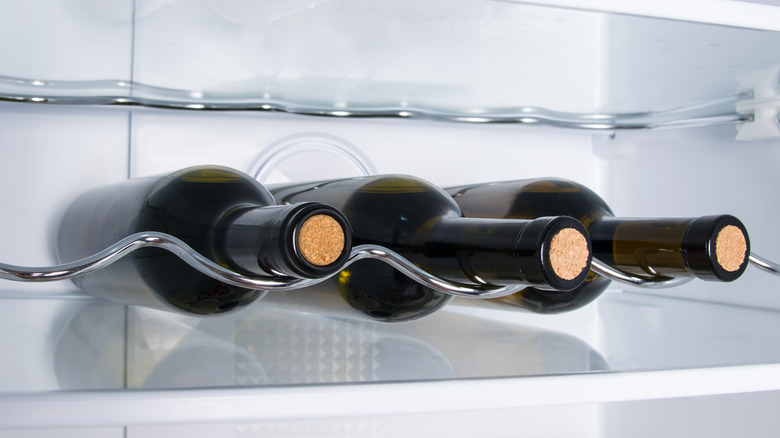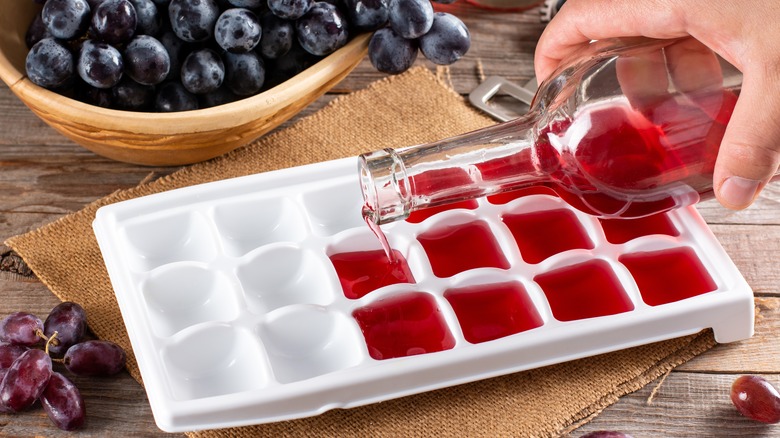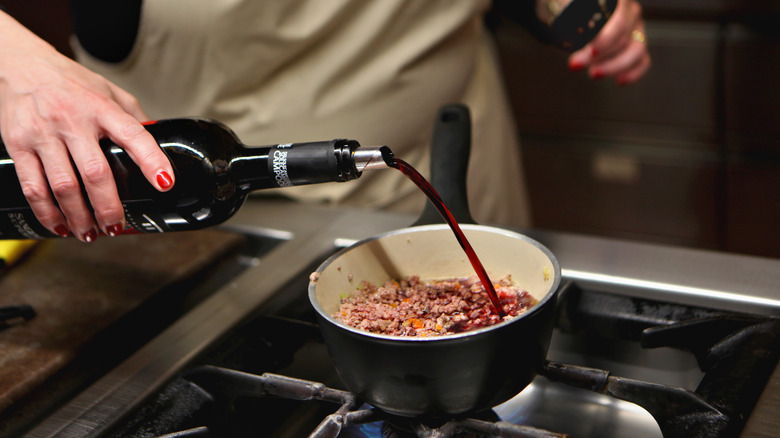The Safety Step You Need To Take Before Drinking Thawed Wine
Have you ever stuffed a bottle of wine into your freezer for a last-minute ice-up before guests arrive? If so, you may have wondered whether wine is freezable. It is — but whether you really want to do that is subject to your taste buds, intended use, and how proactive you are with the process.
It's never advisable to freeze wine inside its original sealed bottle. That's because wine expands as it freezes, which can cause two possible scenarios — one that's annoying and the other dangerous. A mere inconvenience arises if the cork pops out or a screw top comes loose, creating a slushy mess. But if the glass itself cracks or shatters, you've got a safety concern on your hands. If that happens, you're now an impromptu wine inspector. The situation calls for close examination of that bottle, looking for evidence of cracks, slivers, or glass shards. If a full vino explosion has rocked the icy chambers, you'll be seeking out even the smallest bits of glass that could ruin other frozen foods or nick your fingers in future forays. Even if the bottle has remained largely intact, the glass could be compromised by tiny fractures or fissures, potentially contaminating the wine inside. Before drinking thawed wine, inspect both the bottle and wine for tell-tale glistening bits of glass.
But what if you simply want to freeze leftover wine before it oxidizes and loses luster? There are ways to do that — and some things to know beforehand.
Purposefully freezing your favorite wine
Wines is perfectly capable of freezing, but it will take longer than other liquids. The alcohol content in wine, about 11 to 13.5% alcohol by volume (ABV) for most varieties, dictates a freezing temperature of 15 to 25 degrees Fahrenheit, compared to water with a higher freezing point of 32 degrees. Higher alcohol content takes even longer to freeze, which can come into play for some red wines. And the high amount of sugar in sweeter wines has the same effect.
It's best to use dedicated freezer containers or bags for freezing leftover wine, preferably in portion sizes that fit your typical needs. You can also pour wine into ice cube trays and let them thaw into a future glass of wine, creating a refreshing drink that stays cold without dilution as the cube melts. Another phenomenon of frozen wine is the potential presence of tartaric crystals after the wine thaws out. These benign little floaties are normal and safe, so there's no need to filter them out.
As for the flavor of thawed wine, you may be a little disappointed, especially if it was exposed to air and began oxidizing before it froze. If you have a palate that's less demanding than that of an overly devoted wine enthusiast, you may not notice the difference in taste and composition of previously frozen wine. But if you do, get creative with consumption alternatives.
New life for thawed wine
Even if the flavor of your purposefully thawed wine isn't up to par, it's still perfectly fine to drink. Try creating a mixed wine cocktail or wine cooler using fruit juices, herbs, or seasonings. Find a new sangria recipe with white wine, vodka, Triple Sec, and a spicy kick of chili pepper, citrusy lemon-lime soda, and cranberry juice.
Cooking with wine transforms dinner dishes, giving thawed wine a second life that's dignified and delicious. Add red wine to beef stews, braised briskets, French coq au vin, and pasta or barbecue sauces. Go light and easy with a white-wine parfait, custard, shrimp scampi sauce, or creamy fennel soup.
Previously frozen wine also adds flavor complexity and intrigue to baked goods and desserts, including poached pears, truffles, ice cream, fondues, and wine-infused cakes. Make boozy pops out of wine and fruit juice — just label and tuck them out of reach from inquiring little underage freezer foragers.



